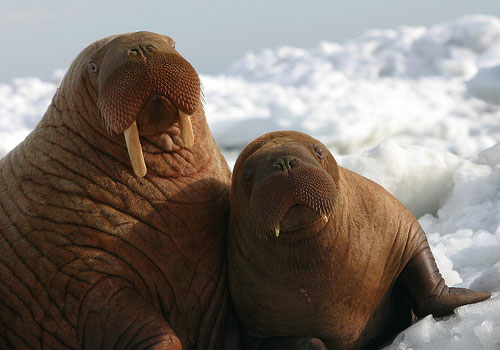
February 09, 2011
The Service’s determination – also known as a 12-month finding – that sufficient scientific and commercial data exist to warrant protecting the Pacific walrus under the ESA was made after a comprehensive review of the best available scientific information concerning the walrus and the threats it faces. This review found that the walrus is primarily threatened by the loss of sea ice in its arctic habitat due to climate change.
Walrus cow and calf on the ice.
While candidate species do not receive protection under the ESA, Pacific walrus in the U.S. are currently protected by the Marine Mammal Protection Act (MMPA) of 1972. Protections afforded under the MMPA are similar to those under the Endangered Species Act and include prohibitions on the harvest, import, export, and interstate commerce of the Pacific walrus or walrus products. The Pacific walrus is found throughout the continental shelf waters of the Bering and Chukchi seas and occasionally in the East Siberian Sea and the Beaufort Sea. Pacific walrus use floating sea ice as a substrate for birthing and nursing calves, resting, isolation from predatorand for passive transport to new feeding areas. The Service has concluded that loss of sea ice – with tresulting changes to walrus distribution and life history patterns this loss entails – will lead to a population decline and is a threat to Pacific walrus in the foreseable future. While dependent on sea ice, Pacific walrus have shown an ability to use land-based haulouts when sea ice is unavailable, and to use those haulouts to rest between feeding periods offshore. Over time, walrus will be forced to rely on terrestrial haulouts to a greater extent. This will expose all individuals, but especially calves, juveniles, and females, to increased levels of stress from depletion of prey, increased energetic costs to obtain prey, trampling injuries and mortalities, and predation. While current subsistence harvest of Pacific walrus by Alaska natives is believed to be sustainable, if sea ice loss occurs as expected, the current level of subsistence harvest will become a threat in the forseeab The precise current size and current trends in the number of the Pacific walrus is unknown. The last joint U.S./Russian survey was conducted in 2006 using thermal imaging systems and satelliet transmitters. The number of Pacific walrus within the surveyed area was estimated at 129,000. This is considered a minimum estimate, since weather conditions forced an early end to the survey and not much of the southwest Bering Sea was completed. The Service will review the Pacific walrus' status as a candidate species annually, and develop a proposed rule to protect the species under the ESA as priorities allow. Any future proposal to add the Pacific walrus to the federal list of threatened and endangered species will be subject to public revand comment. On February 8, 2008, the Service received a petition dated February 7, 2008, for the Center for Biological Diversity to list the Pacific walrus as threatened or endangered under the ESA and to designate critical habitat. On September 10, 2009, the Service published a 90-day finding stating tsubstantial scientific or commercial information indicated that the petitioned action may be warradue to effects on walrus resulting from changes in climate and sea-ice habitats. Today’s publication constitutes the 12-month finding on the February 7, 2008, petition to list the Pacific walrus as endangered or threatened.
Source of News:
Publish A Letter in SitNews Read Letters/Opinions
|
